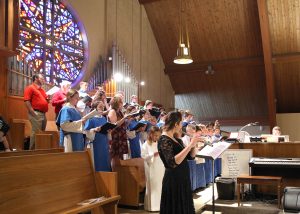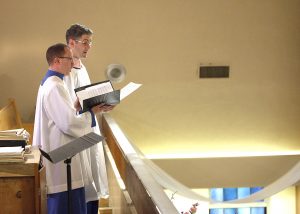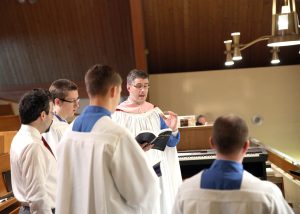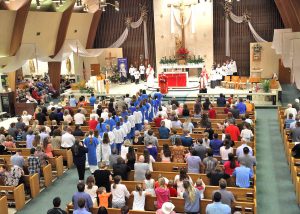Some weeks ago I addressed the challenge of teaching your singers to breath well and today I hope to continue the conversation, focusing on your choir’s tone quality. I remember well the numerous school and church choirs I sang in throughout my youth and to the best of my knowledge, not one of those choirs’ directors ever mentioned tone quality, much less worked with us to achieve a certain choral sound. The vast majority of our time was spent learning notes and paying attention to the odd, but occasional triple forte encountered on Easter morning. However, if you hope to lead your singers to greener pastures, working on the quality of your choir’s tone produces great dividends.
Warm-ups
I continue to be amazed by the number of choir directors who believe the entire purpose of warm-ups is simply to warm-up their singers’ voices. Perhaps the name warm-up is misleading, because there are so many other things the choir director can accomplish at the same time time. Use this time to build your choir vocally, especially focusing on problems they will encounter during rehearsal in the music.
Listening
The greatest skill you can teach your singers is to listen, both to themselves and to each other. They should sing everything as softly as necessary in order to learn to listen and to become aware of what comes out of their own mouths and the mouths of their fellow singers. When they prove adept at listening, THEN you may allow them to sing louder (just beware that you will need to constantly reinforce listening). All of my experience, though, has taught me that soft singing cures a great number of vocal faults.
Resonance
Resonance is extremely important! Ask your singers if any play the violin or guitar and inquire what would happen if they were to remove the instrument’s strings, stretch them as tightly as possible and then bow or pluck them. The strings would vibrate and make noise, albeit very softly. The sound box, because it vibrates in tandem with the strings, acts as a resonator and amplifies the sound of the strings. The same phenomenon happens to the human voice. As the vocal folds or chords begin to vibrate, they cause cavities in areas around the nose and mouth to resonate and amplify the sound. In this way, the voice is given life.
Help your singers to become aware of the natural resonance already taking place as they sing. Ask them to buzz like bees or to sing a very nasally ee and place their fingers to their noses and cheeks and feel the vibrations. Utilize warm-ups that build resonance and you will find your choir much improved in a few short weeks.
I also find it helpful to avoid overly technical language with most choir members, especially children. For the youngest ones, I simply sing the line of a hymn without resonance and then sing it with resonance and ask them if they hear the difference. They can always hear the difference and are often able to mimic both ways of singing.
Head Voice and Chest Voice
In the beginning stages of your work, strive for a greater use of the head voice, especially by singing everything softly. Often untrained singers have picked up a number of bad vocal habits, most of which result in undue tension place on the voice and singing softly reduces and eliminates this tension. This also encourages singers to listen louder than they sing and will help the overall blend of your choir.
Begin the warm-up with descending scales. The high notes encourage your singers to start in the head voice, and if you make sure they continue to sing quietly, they will bring the head voice down into the lower registers. What you don’t want is for them to start in a lower register in the chest voice and force the chest voice into the higher registers of their range, resulting in unhealthy tension.
Eventually, you will want to introduce the chest voice into warm-ups and into the repertoire, making sure that singers don’t introduce undue tension as they do. The addition of the chest voice adds color to music that would otherwise sound very emotionally restrained.
Vowels
Lastly, I would like to mentioned the manner in which choristers sing vowels and how it affects the tone quality of your choir’s sound. Just as Bostonians sound different from Mid westerners and Iowans speak differently from Georgians, the members of your choir will surely sing vowels differently one from another. Your job is to unify their pronunciation on beautiful vowel sounds. If your choir sings primarily in Latin, you will have a much easier time. I personally follow the Liber usualis for Latin pronunciation and Madeleine Marshall’s English Diction for Singers for English.
Conclusion
The ultimate goal of the choral director is to communicate through the music. In the end it doesn’t matter if your choir resonates well and sings beautiful vowels but can’t communicate. However, it would be pretty hard to communicate without these things.






